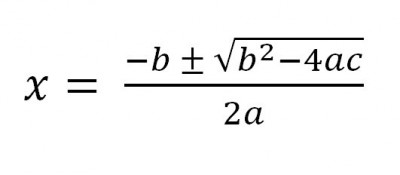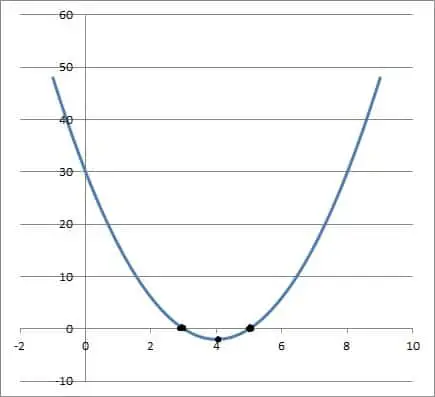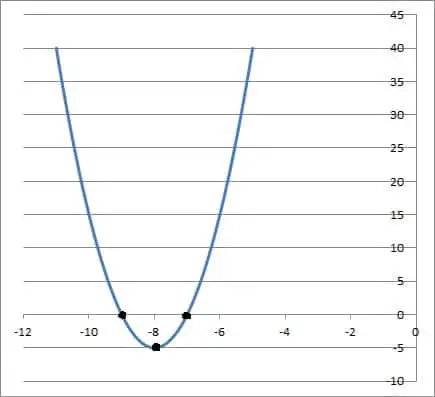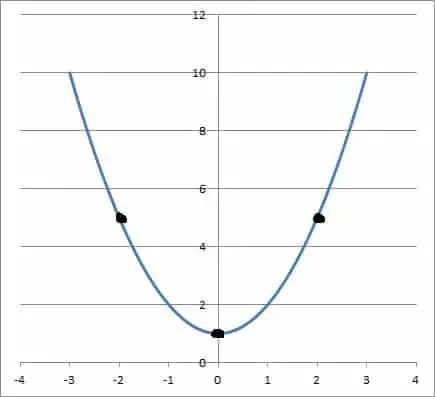A quadratic has 3 different forms, and we can switch between all of them with a little algebra. The factored form is helpful for several reasons, so it pays off to know what it is and what it tells you.
So, what is quadratic factored form? A function in quadratic factored form looks like this: f(x) = a(x – r)(x – s), where a is not zero and r & s are zeros of the function. This form tells us where the function is zero. We can also average those zeros to find the x-coordinate of the vertex of the parabola to graph it more easily.
Of course, once you are comfortable with the quadratic factored form, it will be much easier to work with it, graph from it, and convert it to other forms.
In this article, we’ll talk about what quadratic factored form is and what it looks like. We’ll also look at some examples and answer some common questions about this form.
Let’s get started.
What Is Quadratic Factored Form?
Quadratic factored form looks like this:
f(x) = a(x – r)(x – s)
where a is not zero, and r & s are the zeros (roots) of the equation.
Note that the a in the quadratic factored form is the same one as in standard form of a quadratic:
f(x) = ax2 + bx + c
(You can get a refresher on quadratic functions and the 3 forms in my article here).
Quadratic factored form is useful for several reasons:
- It is easy to find the zeros of the function in this form (they are x = r and x = s)
- It is easy to find the vertex of the corresponding parabola (the x-coordinate is the average of r and s)
- It is easy to find points to start graphing the corresponding parabola (use the vertex as a base, and use the zeros if the function has them).
Let’s take a look at some examples to show how to do all of these things (finding the zeros, finding the vertex, and graphing the parabola).
How To Find The Zeros Of A Quadratic Function In Factored Form
To find the zeros of a quadratic function in factored form, find the x values that will make the expression inside each set of parentheses equal to zero.
That is, if the function has the form
- f(x) = a(x – r)(x – s)
then the zeros are x = r and x = s.
This tells us that f(r) = 0 and f(s) = 0. This information is helpful when graphing the corresponding parabola.
Let’s look at some examples to make sure the concept is clear.
Example 1: Finding The Zeros Of A Quadratic Function In Factored Form
Let’s say our quadratic function in factored form is:
- f(x) = 2(x – 3)(x – 5)
Here, we can see that a = 2, r = 3, and s = 5.
So, the zeros of the function are r = 3 and s = 5.
So f(3) = 0 and f(5) = 0.
Example 2: Finding The Zeros Of A Quadratic Function In Factored Form
Let’s say our quadratic function in factored form is:
- f(x) = 5(x + 7)(x + 9)
Don’t be too hasty and make a mistake! We should rewrite (x + 7) as (x – (–7)) and (x + 9) as (x – (–9)):
- f(x) = 5(x – (–7))(x – (–9))
Here, we can see that a = 5, r = -7, and s = -9.
So, the zeros of the function are r = -7 and s = -9.
So f(-7) = 0 and f(-9) = 0.
How To Find The Vertex Of A Quadratic Function In Factored Form
To find the vertex of a quadratic function in factored form, we take the average of the zeros.
So, for the quadratic in factored form
- f(x) = a(x – r)(x – s)
we calculate c = (r + s) / 2 to find the x-coordinate of the vertex.
Then, we plug in x = c into the function f(x) to find the y-coordinate of the vertex (we’ll call it d). We can also find an equation for this y-coordinate d:
- f(c) = a((r+s)/2 – r)((r+s)/2 – s) [plug in x = (r + s) / 2 for the function f(x)
- f(c) = a((r+s)/2 – 2r/2)((r+s)/2 – 2s/2) [rewrite r as 2r/2 and s as 2s/2]
- f(c) = a((r+s-2r)/2)((r+s-2s)/2) [use common denominators to combine numerators]
- f(c) = a((-r+s)/2)((r-s)/2) [combine like terms in numerators]
- f(c) = a((-(r-s))/2)((r-s)/2) [rewrite –r + s as –(r – s)]
- f(c) = -a(r-s)2 / 4
So f(c) = d = -a(r-s)2 / 4.
The coordinates of the vertex are (c, d), where c = (r + s) / 2 and d = -a(r – s)2 / 4
The question is, why does this method of finding the vertex work?
Well, remember that the zeros of a quadratic equation are given by the quadratic formula:

If we take the average of the two zeroes, we need to add them up and then divide by 2.
First, we add the two zeros. When we do that, the positive and negative signs in front of the radicals cancel each other out to zero.
All that will be left is (-b + -b)/2a = -2b/2a = -b/a.
Now, we divide by 2 to get (-b/a)/2 = -b/2a, which is the average of the sum of the roots of the quadratic.
We can verify that this is the vertex in two ways. One way is to take the derivative of the quadratic function f(x) = ax2 + bx + c.
The first derivative of f(x) is f’(x) = 2ax + b. This derivative is zero when:
- f’(x) = 0
- 2ax + b = 0
- 2ax = -b
- x = -b/2a
So, the vertex is at the lowest (or highest) point of the graph, when the derivative is zero (a horizontal or flat tangent line).
Let’s look at some examples to see how to find the vertex from quadratic factored form in practice.
Example 1: Finding The Vertex Of A Quadratic Function In Factored Form
Let’s go back to the quadratic function in factored form from the first example above:
- f(x) = 2(x – 3)(x – 5)
Here, we can see that a = 2, r = 3, and s = 5. We already know that the zeros are r = 3 and s = 5.
So, we take their average to find the x-coordinate of the vertex:
- c = (r + s) / 2 [equation for vertex of parabola in terms of roots]
- c = (3 + 5) / 2 [r = 3, s = 5]
- c = 4
To find the y-coordinate of the vertex, we can plug this value (c = 4) into the function f(x):
- d = f(c)
- d = 2(c – 3)(c – 5) [equation for f(x) with x = c]
- d = 2(4 – 3)(4 – 5) [c = 4]
- d = 2(1)(-1)
- d = -2
So, the vertex has coordinates (c, d) = (4, -2).
Example 2: Finding The Vertex Of A Quadratic Function In Factored Form
Let’s go back to the quadratic function in factored form from the second example above:
- f(x) = 5(x + 7)(x + 9)
Here, we can see that a = 5, r = -7, and s = -9. We already know that the zeros are r =-7 and s = -9.
So, we take their average to find the x-coordinate of the vertex:
- c = (r + s) / 2 [equation for vertex of parabola in terms of roots]
- c = (-7 + -9) / 2 [r = -7, s = -9]
- c = -8
To find the y-coordinate of the vertex, we can plug this value (c = -8) into the function f(x):
- d = f(c)
- d = 5(c + 7)(c + 9) [equation for f(x) with x = c]
- d = 5(-8 + 7)(-8 + 9) [c = -8]
- d = 5(-1)(1)
- d = -5
So, the vertex has coordinates (c, d) = (-8, -5).
How To Graph Using Quadratic Factored Form
The best way to graph using quadratic factored form is to start by plotting a few key points:
- If the quadratic has two distinct real zeros (positive discriminant), then plot those two zeros along with the vertex.
- If the quadratic has one real zero or two distinct complex zeros (zero discriminant or negative discriminant), then plot the vertex and two nearby points (such as the points for x = c -1 and x = c – 1).
After plotting the 3 key points, fill in the sketch in the shape of a parabola so that it goes through the 3 points.
Let’s take a look at some examples to see how this works in practice.
Example 1: Drawing A Graph Using Quadratic Factored Form
Once again, consider the quadratic function in factored for from earlier examples:
- f(x) = 2(x – 3)(x – 5)
Here, we can see that a = 2, r = 3, and s = 5.
So, the zeros of the function are r = 3 and s = 5. This gives us points (3, 0) and (5, 0) on the graph.
The vertex is the point (4, -2).
So, we will graph our 3 key points: (3, 0), (5, 0), and (4, -2) and sketch the graph of a parabola that goes through all 3 points:

Example 2: Drawing A Graph Using Quadratic Factored Form
Once again, consider the quadratic function in factored for from earlier examples:
- f(x) = 5(x + 7)(x + 9)
Here, we can see that a = 5, r = -7, and s = -9.
So, the zeros of the function are r = -7 and s = -9. This gives us points (-7, 0) and (-9, 0) on the graph.
The vertex is the point (-8, -5).
So, we will graph our 3 key points: (-7, 0), (-9, 0), and (-8, -5) and sketch the graph of a parabola that goes through all 3 points:

Example 3: Drawing A Graph Using Quadratic Factored Form
Now let’s try drawing the graph of a parabola where the quadratic has complex zeros (no real zeros).
We’ll look at f(x) = x2 + 1, whose zeros are i and –i (remember that i is the square root of -1).
First, we find the vertex by taking the average of the zeros. This gives us an x-coordinate of c = (i + -i) / 2 = 0.
The y-coordinate would be d = f(c), or f(0) = 02 + 1 = 1.
So, the vertex of this parabola is (0, 1).
To find two other points for graphing, use points that are the same distance to the left and right of the vertex.
Here, we’ll choose x = -2 and x = +2 (both are a horizontal distance of 2 from c = 0).
By symmetry, f(2) = f(-2) = 5. So, our two other points are (-2, 5) and (2, 5).
So, we will graph our 3 key points: (-2, 5), (2, 5), and (0, 1) and sketch the graph of a parabola that goes through all 3 points:

Conclusion
Now you know what quadratic factored form is and how it can be useful for graphing the corresponding parabola by finding the zeros and vertex.
You can learn about quadratic vertex form here.
You can learn about how to solve and graph quadratic inequalities in my article here, or learn more about what the solutions of a quadratic equation represent in my article here.
You can learn more about the roots and coefficients of a quadratic equation in my article here.
You might also want to read my article on when a quadratic function is negative or my article on how to change the shape of a parabola.
I hope you found this article helpful. If so, please share it with someone who can use the information.
Don’t forget to subscribe to my YouTube channel & get updates on new math videos!
~Jonathon

